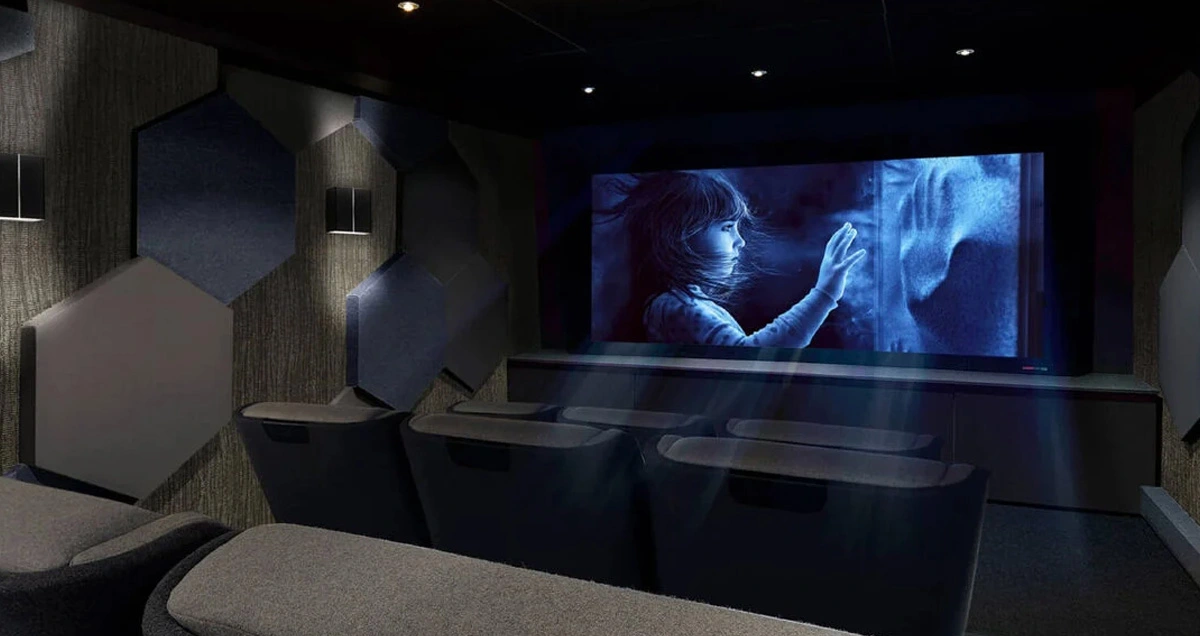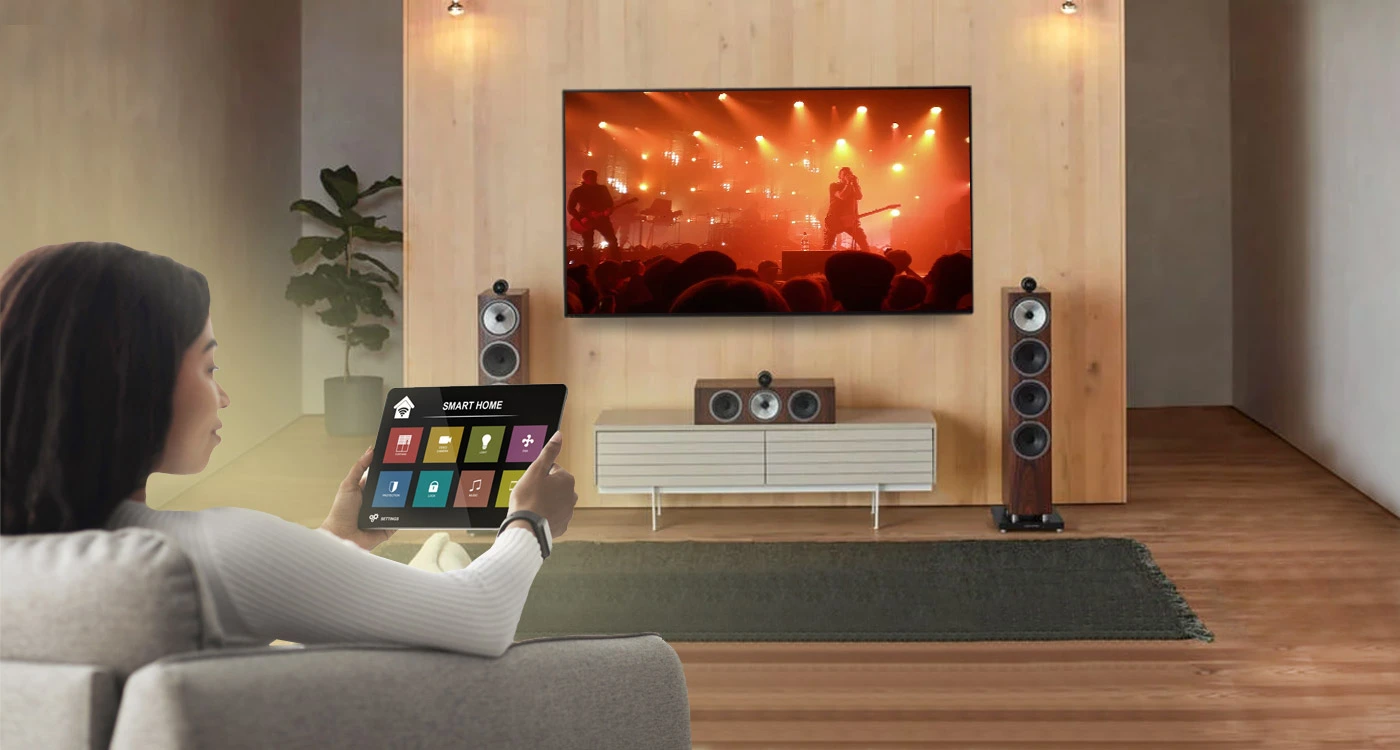Distributed AV systems are becoming a regular feature in many smart homes due to their ability to provide audio and video, whenever and wherever you want it
Distributed Audio-Visual (AV) systems have come a long way since their inception. Initially, they were exclusive to commercial spaces like shopping malls and offices. However, with the advent of smart homes, distributed AV has found its way into our living rooms, kitchens and bedrooms, revolutionising home design in the process.
The concept of distributed AV is not new. It has been around for decades, but it was primarily used in commercial settings. Shopping malls, offices and other large spaces needed a way to distribute audio to multiple areas simultaneously. This was achieved through a network of speakers, amplifiers and matrix switchers connected to a central hub. However, these systems were often complex and expensive.

Image credit – Epson – Projection Mapping Illustration
With the advent of smart homes, the potential for distributed AV in residential settings became apparent. Homeowners wanted the same level of convenience and control that they experienced with their smartphones. They wanted to be able to watch their favourite shows or listen to their favourite music in any room of the house without having to carry around their AV gear. This led to the development of residential distributed AV systems.
These systems have evolved significantly over the years. For one, the early version required extensive wiring. However, advancements in wireless technology have made these systems more accessible and affordable. Today, you can easily set up an AV-over-IP system in your home using wireless speakers and displays. The use of ethernet instead of expensive audio cables not only makes the overall system hugely cost-efficient but also offers excellent performance and control for audio and video. This has opened up a whole new world of possibilities for home design.
Distributed AV – A Smart Home’s Best Friend
Distributed AV is not just for tech enthusiasts or the ultra-rich. It’s for anyone who values convenience, control and quality in their home entertainment experience. A distributed AV system typically consists of a central hub that connects to speakers and displays throughout the house. This allows for seamless distribution and control of audio and video content across multiple rooms.
The beauty of distributed AV lies in its simplicity. At its core, it’s about delivering audio and video content where and when you want it. This is achieved through streaming services or by creating a central content hub (like a media server) that connects to various output devices throughout your home. These devices can include speakers, TVs, projectors and even smart devices like tablets and smartphones.
Also Read:- The Future of Smart Home Automation

Image credit – Epson – Projection Mapping Illustration
The central hub acts as the brain (media server + control processor) of the system. It receives input from various sources, such as your cable box, Blu-ray player, or streaming device and distributes it to the appropriate output devices. This allows you to watch your favourite show in the living room, continue watching it in the kitchen while you make dinner and finish it in the bedroom without missing a beat.
But distributed AV is not just about convenience. It’s also about control – which is achieved with a centralised control system which runs in parallel to the content distribution. With a distributed AV system, you have complete control over what is playing in each room. You can play the same content in all rooms, or you can play different content in each room. This is perfect for larger families with different entertainment preferences.
Distributed AV Solutions in the Real World
There are several well-known AV Solutions in the market today, each with its unique features and benefits. Crestron is a key player in the distributed AV market. Their solutions are known for their unique distributed architecture that unifies technologies in any building, allowing them to communicate and work together intelligently. Crestron’s AV Framework is a web-based configuration platform built into their products, making room technology simple to configure and easy to use and manage.
With the help of the DanteTM network protocol, speakers like the Devialet Phantom Custom can transmit high-quality audio signals over standard IP networks, representing a significant advancement in audio distribution technology. It is engineered to integrate seamlessly into distributed audio systems, commonly used in multi-room setups and commercial spaces. This makes it an ideal choice for environments where audio needs to be distributed across various zones without loss of quality.
Many Networked AV systems also help achieve distributed audio in homes. With Crestron’s DM NVX, you can expand your signal distribution far more efficiently than matrix switchers. This level of integration and control makes Crestron a popular choice for those looking to implement distributed AV in their homes. Their solutions help create a consistent room experience across multiple spaces, making it easier and more economical to replicate rooms. This is particularly useful in large homes or properties with multiple entertainment areas.

A typical distributed AV setup

A typical distributed AV setup
The use of this protocol ensures low latency and synchronised playback across different speakers within the network. Its compatibility with professional control systems enhances its applicability in distributed AV systems, allowing for centralised control and management of audio outputs. This is crucial for maintaining consistency and ease of use in complex installations.
These are just a few examples of companies offering innovative distributed AV solutions. Each has its unique features and benefits, so it’s important to do your research and choose the one that best fits your needs.
Distributed AV systems can also help enhance productivity and convenience. For example, imagine starting your day with your favourite news channel in the kitchen. As you move to the living room to enjoy your coffee, the same news channel continues playing on the TV. And when you’re ready to start your workday, you can switch to your favourite productivity playlist with just a few taps on your smartphone.
Distributed AV – A Smart Home’s Best Friend
The future of distributed AV is set to be shaped by several exciting technologies. One of the key trends is the development of flexible OLED screens. These screens, which can be rolled up, offer significant space-saving and portability advantages. While some prototypes and high-end consumer models are already available, mass production of larger flexible OLED screens is on the horizon.
We can expect distributed AV technology to become even more integrated and user-friendly with advancements in AI and machine learning. These systems will become smarter, learning our preferences and routines to provide a truly personalised experience. They can automatically play your favourite music when you wake up, turn on the news when you’re having breakfast and switch to your favourite show when you’re ready to relax.
This level of personalisation is set to revolutionise the way we consume audio and video content at home. So, whether you’re a movie buff, a music lover, or just someone who appreciates a well-designed home, distributed AV is set to make your home more entertaining, comfortable and stylish in the coming years.
Ready to transform your home with a state-of-the-art distributed AV solution? Partner with Actis Technologies, India’s leading systems integrator with a legacy of over 5 decades in the AV space. Get in touch with us at 022-30808000 today.
Ready to transform your home with a state-of-the-art distributed AV solution? Partner with Actis Technologies, India’s leading systems integrator with a legacy of over 5 decades in the AV space. Get in touch with us at 022-30808000 today.


